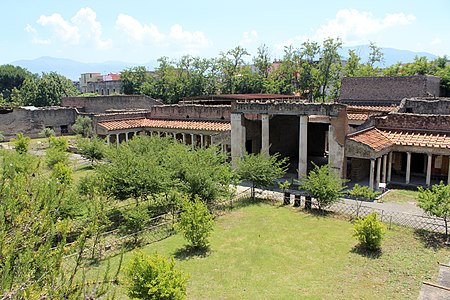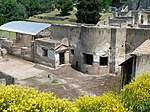Villa Poppaea

The Villa Poppaea is an ancient luxurious Roman seaside villa (villa maritima) located in Torre Annunziata between Naples and Sorrento, in Southern Italy. It is also called the Villa Oplontis or Oplontis Villa A. as it was situated in the ancient Roman town of Oplontis. It was buried and preserved in the eruption of Vesuvius in 79 AD, like the nearby cities of Herculaneum and Pompeii, about 10 m (33 ft) below modern ground level. The quality of the decorations and construction suggests that it was owned by the Emperor Nero, and a pottery shard bearing the name of a freedman of Poppaea Sabina, the second wife of the emperor Nero was found at the site, which suggests the villa may have been her residence when she was away from Rome and which gives it its popular name.It was sumptuously decorated with fine works of art. Its marble columns and capitals mark it out as being especially luxurious compared with others in this region that usually had stuccoed brick columns. Many artifacts from Oplontis are preserved in the Naples National Archaeological Museum. Parts of the villa lying under modern structures remain unexcavated.
Excerpt from the Wikipedia article Villa Poppaea (License: CC BY-SA 3.0, Authors, Images).Villa Poppaea
Via Sepolcri,
Geographical coordinates (GPS) Address External links Nearby Places Show on map
Geographical coordinates (GPS)
| Latitude | Longitude |
|---|---|
| N 40.757222222222 ° | E 14.4525 ° |
Address
Villa Poppaea
Via Sepolcri
80058 , Rione Murattiano
Campania, Italy
Open on Google Maps










